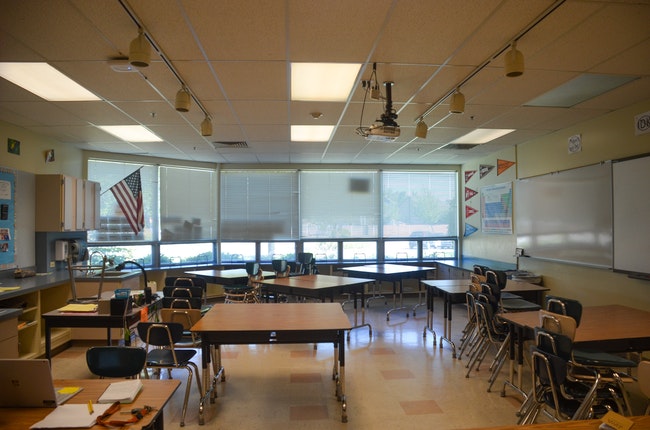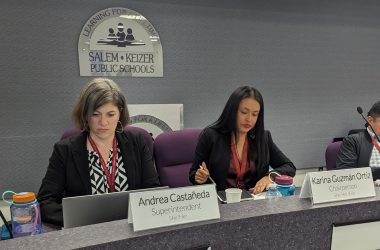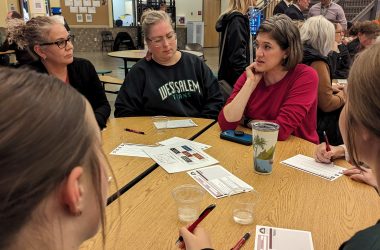
An empty classroom at Stevens Middle School on Aug. 18, 2020 (Rachel Alexander/Salem Reporter)
[ NOTE: Salem Reporter is providing this information free as a community service. You can support dissemination by subscribing. ]
About 2% of school employees and 1% of students would become infected with Covid between September and December if Salem resumed in-person elementary school at current infection rates, a new report shows.
An Aug. 13 report from the Institute for Disease Modeling simulated these numbers if schools used masks, sanitized, grouped students, and screened for disease, all requirements under Oregon’s plans for in-person instruction.
The research shows Oregon is being more conservative than some researchers say is necessary. Oregon’s guidelines require no more than 10 Covid cases per 100,000 county residents in a week to resume full in-person classes, with some exceptions for rural and remote districts.
If schools resume in-person at those rates, the report predicts about 0.6% of students and 0.8% of teachers and school staff would become infected over three months.
Marion County last week reported 281 new cases of the virus, about nine times the number allowed for Salem-Keizer to resume in-person classes for all students, and three times the number needed to resume kindergarten through third grade in-person. Gov. Kate Brown said it could take until April for all of Oregon’s students to be back in the classroom at the current pace of infections.
The report also found that as long as there are sufficient countermeasures in schools, in-person learning will not increase community transmission.
The study concluded that in-person instruction where students are split into Monday-Tuesday and Wednesday-Thursday groups with precautions would reduce the number of infections even further. Salem-Keizer is planning a split schedule when classes resume in-person.
“What we have found is that there is no ‘zero-risk’ scenario for resuming in-person instruction in Washington state schools,” said Jamie Cohen, a co-author of the IDM report, in a press release. “But our analysis shows that there are pathways to resuming limited and carefully monitored in-person instruction for younger students. This can happen only if everyone works together to minimize disease transmission in their local communities.”
Oregon’s school reopening requirements, from Aug. 11, say that Marion County could have no more than 10 cases per 100,000 residents, or more than 34 cases, every week for three weeks.
The requirements were not supported by any formal report or analysis, said Thomas Jeanne, deputy state epidemiologist.
The decision to set the metrics was mostly done by consensus of senior health officials after extrapolating data of case counts from previous Covid spikes in Oregon, looking at national recommendations, checking with other state guidance and reviewing 15 countries’ case rates when schools were reopened in those countries, said Jeanne.
But four of the six countries the state said opened schools at the correct time actually could not reopen schools if they followed Oregon’s guidance, because their cases were as far as three times higher than what the state would allow in the weeks leading up to school reopening, a review of data from the Malheur Enterprise showed.
The Oregon Health Authority, when explaining the guidelines, cited a previous study from the Institute of Disease Modeling.
The authority said that “unless community spread is reduced, reopening schools to in-person instruction, even with protective measures like physical distancing and face coverings, will cause significant growth of the epidemic.”
But Dan Klein, who wrote the modeling report, said that wasn’t the best way to characterize the report.
If the number of new infections caused by every infected person is fewer than one, schools can reopen as long as they follow prevention methods, said Dan Klein, report author.
Marion County is just under that threshold now, with each person infected with Covid on average infecting 0.95 other people, according to Harvard research from Aug. 25.
Klein couldn’t comment on the state’s school reopening requirements, but he said the Oregon Health Authority’s approach of looking at other countries’ case rates is useful since there is not a lot of research completed on the new virus.
Schools nonetheless are not going to be zero risk if they do reopen in-person, said Klein.
The health authority also cited a study for the Pennsylvania Department of Education, which said that schools reopening will increase Covid spread, but that prevention strategies can significantly help.
Certain factors must be considered when reopening schools, like “…the rate of infections in the local community, the size of the school, and the age of students (and corresponding ability to learn at home),” the state agency said, citing that Pennsylvania study.
But that study also advised that “schools in different circumstances might reasonably make different decisions.”
A Brookings Institution analysis in July of reopening plans for 256 U.S. school districts representing 13 million students found partisan politics appeared to be driving school reopening decisions more than the rate of new coronavirus cases.
The analysis, by senior fellow Jon Valant, found virtually no relationship between whether a district planned to offer in-person classes to all students or remote instruction only and the number of new coronavirus cases reported in the surrounding county in July.
Instead, districts located in counties where a majority of voters supported President Donald Trump in 2016 were more likely to reopen in-person classes, while districts in counties supporting Hillary Clinton were more likely to offer remote instruction only, researchers found.
Oregon’s plans were relatively strict when announced in late July, though some states, including California, have since tightened rules after seeing rising case counts and pushback from teachers. In neighboring Washington, 80% of school districts which enroll 94% of the state’s students are starting school remotely this fall.
Minnesota, a liberal state which has reported more coronavirus cases per resident than Oregon, is allowing schools to hold in-person classes so long as the counties they’re in report no more than 10 new coronavirus cases per 10,000 residents in a week. Oregon’s metric is 10 cases per 100,000 residents over one week, one-tenth the number Minnesota’s plan would allow.
Iowa schools aren’t allowed to teach virtually at all unless the county test positivity rate exceeds 15%, under orders from the governor. The state’s plan to resume in-person instruction has sparked pushback from health experts and a lawsuit from teachers.
Idaho, meanwhile, gives local school districts the ability to choose how to teach.
Rachel Alexander contributed reporting.
Contact reporter Aidan McGloin at [email protected] or at 541-473-3377.
SUPPORT ESSENTIAL REPORTING FOR SALEM – A subscription starts at $5 a month for around-the-clock access to stories and email alerts sent directly to you. Your support matters. Go HERE.









